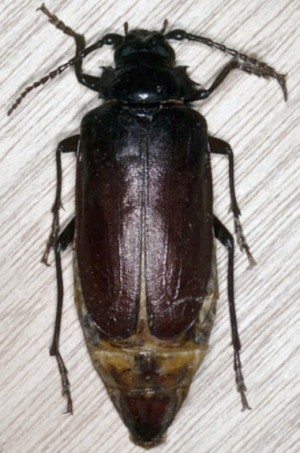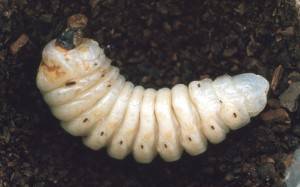Prionus Root Borer
 Scientific Name
Scientific Name
Prionus sp.
Hosts
A wide variety of trees including pecan, oak, apple, cherry, dogwood, maple, pine, etc. (usually younger or weakened trees).
Symptoms
Unexplained loss of young trees or secondary problem noticed on a weakened tree. Gradual thinning and yellowing of foliage throughout the crown and gradual limb-by-limb mortality. Larvae chew away large patches of bark and feed on the inner tissue of roots. This feeding creates burrows that often extend into and through large roots, frequently honeycombing the interior. Larvae may cut off small trees at the root collar or just below the soil line. These already weakened trees die quickly.
Description
 The adults are large (1 ½ to 2 inches long), robust, reddish brown to black beetles
with long antennae (up to length of their bodies). The larvae are creamy white or
yellow with brown heads. Mature larvae may be as long as 4 inches. Adult beetles emerge
from the soil in late spring and early summer and are often attracted to lights at
night. Eggs are laid in the soil near the host trees. Mature larvae pupate in earthen
cells 8 to 12 inches below the soil surface. The adults emerge from these cells and
burrow to the soil surface. A single generation may take 3-5 years to complete.
The adults are large (1 ½ to 2 inches long), robust, reddish brown to black beetles
with long antennae (up to length of their bodies). The larvae are creamy white or
yellow with brown heads. Mature larvae may be as long as 4 inches. Adult beetles emerge
from the soil in late spring and early summer and are often attracted to lights at
night. Eggs are laid in the soil near the host trees. Mature larvae pupate in earthen
cells 8 to 12 inches below the soil surface. The adults emerge from these cells and
burrow to the soil surface. A single generation may take 3-5 years to complete.
Control
Please contact your local county extension office for current information.
